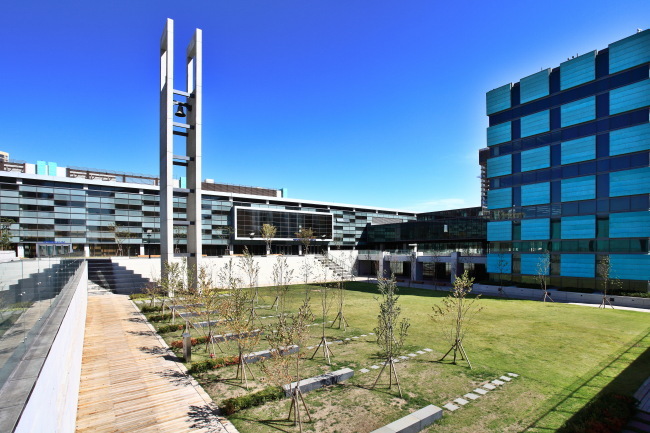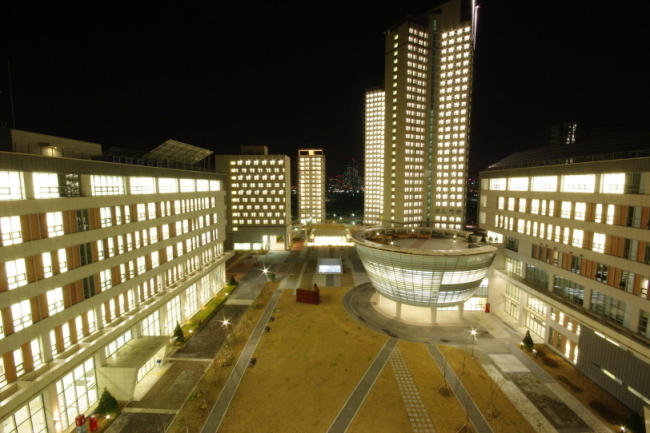A stroll through the beautiful campus of Chadwick International in Songdo, Incheon, is nearly enough to make a visitor forget this is a Korea-based school: Posters on the wall are in English, teachers are foreign and the animated discussions heard in the hallways are also in English.
But a glance of the faces of the students is enough to snap the visitor back to reality, as the school consists of 80 percent Koreans.
There has been criticism among education circles that foreign education institutes in South Korea ― originally established for the benefit of expatriates here ― are quickly becoming schools sought by privileged Koreans with a fat wallet and a distaste for domestic education, as their English-based curriculum is left largely unchecked by education authorities.
There are currently seven foreign educational institutes in free economic zones across Korea. Five of them are in the Incheon Free Economic Zone.
Clause 1 of the law on foreign education institutes states that its primary reason is to “enhance the quality of education for foreigners.”
But a glance of the faces of the students is enough to snap the visitor back to reality, as the school consists of 80 percent Koreans.
There has been criticism among education circles that foreign education institutes in South Korea ― originally established for the benefit of expatriates here ― are quickly becoming schools sought by privileged Koreans with a fat wallet and a distaste for domestic education, as their English-based curriculum is left largely unchecked by education authorities.
There are currently seven foreign educational institutes in free economic zones across Korea. Five of them are in the Incheon Free Economic Zone.
Clause 1 of the law on foreign education institutes states that its primary reason is to “enhance the quality of education for foreigners.”

As the primary target of education is the children of expatriates, the law stipulates that the percentage of domestic students allowed to enroll in a foreign education institute cannot exceed 30 percent, although the education superintendent of the region can grant the extension of the ratio to 50 percent.
But according to data revealed by Rep. Jeong Jin-hoo of the small Justice Party, Korean students accounted for over 70 percent of all students at these schools from 2013 to 2015.
This is possible because the law is based on the student quota, and not the actual number of students.
For example, George Mason University Korea can accept up to 160 students, but only 69 students attended the school in the 2013-14 school year. The maximum number of Korean students condoned by the law is in proportion to the maximum student quota ― 160 ― instead of the actual number of students ― 69.
So while 94.2 percent of the university’s students were Korean, it was still below the maximum student quota allowable by the law. This results in the irony of institutions built for foreigners being mostly filled by locals.
Despite most of their students being Koreans, foreign education institutes are not mandated to be inspected by education authorities.

An Education Ministry directive stipulate that all state-run universities and colleges are to be regularly inspected by the ministry once every three year, and private universities are subject to nonperiodic inspections. Primary and secondary education institutes are inspected by local education offices.
But the directive does not cover foreign education institutes.
An official from the ministry who formerly worked on the directive on inspections explained that these schools are autonomously inspected. In this case, the Songdo campuses report their operations and finances to the main campus back home.
“In the case of other higher education institutes, we (the Education Ministry) give financial support. But we do not subsidize the foreign schools,” said an official from the international cooperation team that overseas foreign schools in Korea.
Earlier this year, the ministry came under flak after Rep. Jeong pointed out that many of the foreign schools, including Chadwick and George Mason, had never been inspected by the ministry. The official said the ministry conducted a regular checkup on the school operation ― such as the student quota and faculty ― but said it was not entitled to inspect certain areas such as finances.
The ministry said that these education institutes were too new to be inspected. State University of New York, Korea, the first U.S. university to be established here, opened in 2012. However, there are no clauses specifying the number of years schools have be operational in order to be subject to inspection.
Although the ministry has announced it will conduct inspections from this year on, the substance of the inspection remains unchanged.
Critics have pointed out that the different standards exclusively applied to foreign schools are viewed as unfair, because mostly Koreans benefit from the system that was designed for foreigners. The international schools’ sky-high tuition have also stoked debate that they aggravate educational disparity among locals.
The annual tuition fees of Chadwick International from grade 9th to 12th was 38.9 million won ($32,400) for the 2014-2015 school year. It was more than double the tuition fee for the Korean Minjok Leadership Academy, the priciest high school in the country, which is about 17.5 million won per year.
“Would I like to send my son to a school that has less than 20 students per class and all-English classes? Sure. But there is no way I can possibly afford it,” said a 33-year-old woman surnamed Kim.
An official from a local civic group on education said the reason so many Koreans flock to foreign schools is because they don’t have to follow the curriculum guidelines from the ministry.
“Thus, they can focus on English and other foreign languages as much as they want. And they do it for a hefty price tag. These schools effectively became the institutes for the modern-day ‘royalty,’” he said.
The foreign schools, however, strongly deny that they are operating as elitist schools for “rich Koreans.”
“Our objectives for our students is completely different from schools that just seek to put as many of their students in top-tier universities as possible. Frankly if grades were their main concern, students would get quicker and cheaper results from going to private institutions than attending our school,” said an official from Chadwick International.
She pointed out that the school’s curriculum is based on discussions and on challenging students to form their own opinions, rather than cramming information into their heads.
While she said it was “understandable” that foreign schools are criticized for having too many domestic students, she dismissed the accusation that these schools serve as exclusive institutes for the education of rich Koreans.
“As schools, we can’t really recruit students. These schools are mostly for the foreigners living in the free economic zone, and the recent economic slump means less foreign investments in the area. Ergo less foreign students, and more Koreans,” she said. “The foreigners-to-Koreans ratio for Chadwick is consistently rising.”
By Yoon Min-sik
(minsikyoon@heraldcorp.com)











![[Today’s K-pop] BTS pop-up event to come to Seoul](http://res.heraldm.com/phpwas/restmb_idxmake.php?idx=644&simg=/content/image/2024/04/17/20240417050734_0.jpg&u=)





![[KH Explains] Hyundai's full hybrid edge to pay off amid slow transition to pure EVs](http://res.heraldm.com/phpwas/restmb_idxmake.php?idx=652&simg=/content/image/2024/04/18/20240418050645_0.jpg&u=20240418181020)

![[Today’s K-pop] Zico drops snippet of collaboration with Jennie](http://res.heraldm.com/phpwas/restmb_idxmake.php?idx=642&simg=/content/image/2024/04/18/20240418050702_0.jpg&u=)